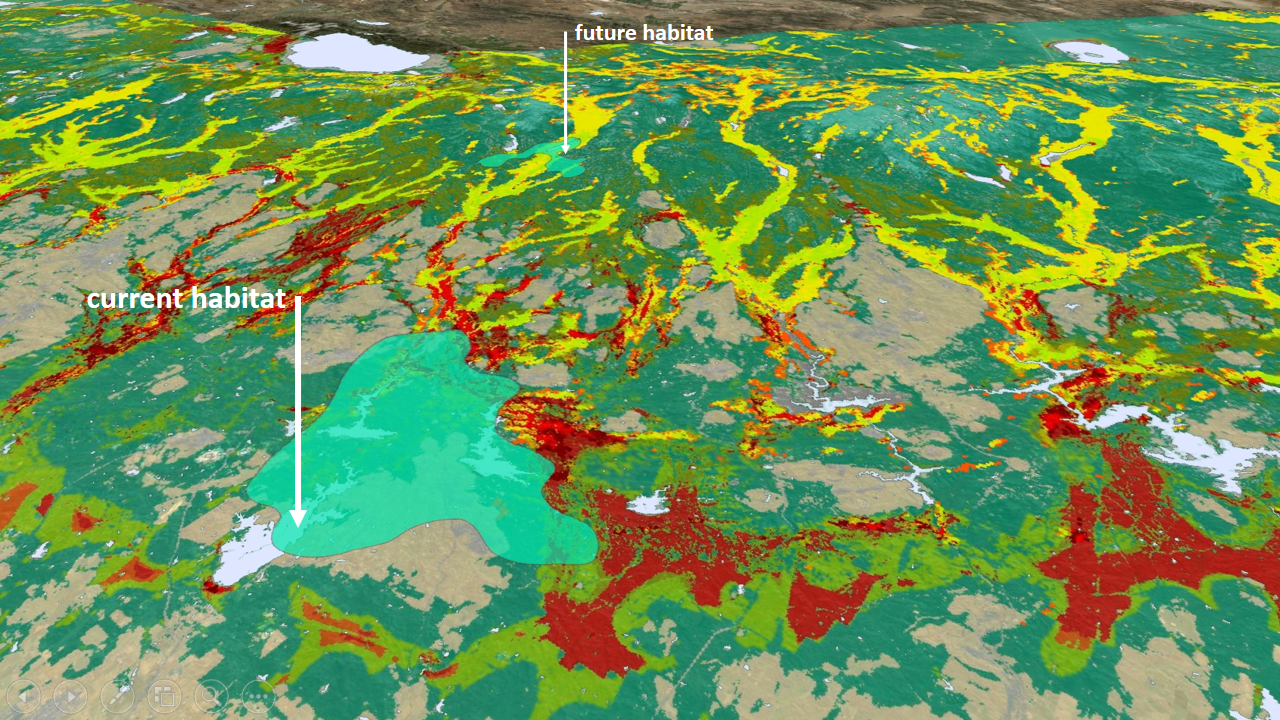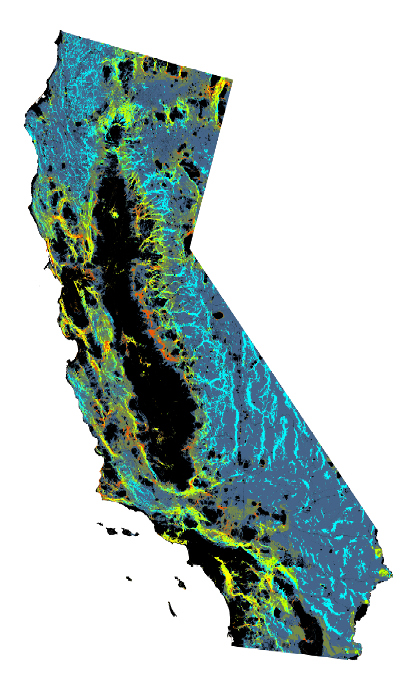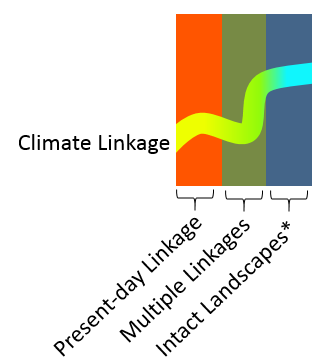Can we identify areas where nature will need to migrate in response to climate change?

Climate linkages connect current habitat to future habitat along pathways that offer a diversity of climate options as stepping stones for animals adapting to climate change. © Dick Cameron/TNC, Carrie Schloss/TNC
Borrowing principles of resistance and flow from electrical engineering, The Nature Conservancy in California mapped ecological connectivity throughout the state.
The climate is changing faster than at any time in recorded history. Catastrophic storms, droughts, floods, and fires are increasingly common. People adjust to these changes by turning up the air conditioning, fighting forest fires, and building infrastructure.
Plants and animals are also feeling the heat, but lack the ability to change their environment. When their territories become uninhabitable, their only option is to leave and search out new habitats. Range shifts have already been detected for many plant and animal populations in response to recent climate change. But adaptation takes time—often many generations—and the climate is changing ten times faster than it has in the past. Even as they struggle to adapt, wildlife attempting to move to new ranges are likely to run into roads, dams, cities and sprawl blocking the way.
Given all these challenges, how do we protect California’s iconic ecosystems—oak woodlands, giant redwood forests, desert chaparral—as well as the plants and animals adapted to live in those systems? With limited resources for protecting additional lands, the conservation community needs to ensure that our priorities and investments optimize for conservation today and under future conditions.

* At the edge of developed areas, may represent lower connectivity potential
Large, undeveloped tracts of land with varied topographies and microclimates may offer the most benefit to plants and animals under climate stress. Over time, these lands provide conditions that allow plants and wildlife to adapt to changing climate. But, identifying these resilient places—and the linkages that can connect them today and in the future—is complicated.
Scientists with the Nature Conservancy in California and in the North American science team, and Conservation Science Partners have been working on mathematical models, or tools, to help map connectivity potential across the state. These tools are helping decision-makers prioritize land protection and infrastructure development efforts.

Carrie Schloss, Dick Cameron, Nathaniel Rindlaub, Connor Shank
This interactive, web-based tour provides an accessible introduction to The Nature Conservancy’s analysis of wildlife movement routes for climate adaptation in California. Viewing these pathways…Brett G. Dickson, Christine M. Albano, Ranjan Anantharaman, Paul Beier, Joe Fargione, Tabitha A. Graves, Miranda E. Gray, Kimberly R. Hall, Josh J. Lawler, Paul B. Leonard, Caitlin E. Littlefield, Meredith L. McClure, John Novembre, Carrie A. Schloss, Nathan H. Schumaker, Viral B. Shah, David M. Theobald
The authors explore the impact that Brad McRae’s development of circuit theory and the associated software, Circuitscape, have had, and continue to have, on connectivity science and…Alex Leumer, Carrie Schloss, Cara Lacey
Plants and animals lack the ability to change their environment. As their current habitat becomes unsuitable due to climate change, they may search out new, more suitable habitat to adapt to changing…H.B. Ernest, T.W. Vickers, S.A. Morrison, M.R. Buchalski, W.M. Boyce
Highly fragmented landscapes can pose myriad threats to wide-ranging species like mountain lions. Coastal southern California has long been the focus of research into demographics, genetics, and…B. C. Mclaughlin, C. N. Morozumi, J. MacKenzie, A. Cole, S. Gennet
Anticipating how species will move as the climate changes is a fundamental concern in 21st century conservation. This study modeled potential responses of blue oak (Quercus douglasii), an…Shaw, M.R., L. Pendleton, D.R. Cameron, B. Morris, D. Bachelet, K. Klausmeyer, J. MacKenzie, D.R. Conklin, G.N. Bratman, J. Lenihan, E. Haunreiter, C. Daly, P.R. Roehrdanz
As the climate warms, changes in ecosystems will impact human communities and livelihoods. This paper, together with a California Energy Commission Scenarios Report of the same name, explores the…Klausmeyer, K. R., M. R. Shaw, J.B. MacKenzie, D.R.Cameron
This analysis provides an approach for distilling complex climate and landscape data into actions land managers can take to help plants and animals adapt to a changing climate. Based on historical…Kirk Klausmeyer, Dan Olstein, Terri Schulz, Robin Cox, Sasha Gennet, Jason MacKenzie
While the literature and guidance on traditional conservation planning methods is extensive, there are few case studies on methods for incorporating climate change into conservation planning efforts.…Scott Morrison, Walter Boyce
Critical for biodiversity conservation is the retention of ecological connectivity in the landscape, so that wildlife—and the natural processes that sustain wildlife—can move around.…